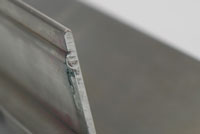WHAT EMULSION COATER SHOULD I USE?
Use an emulsion trough with a rounded (2mm) thick edge and a thin edge. Use the rounded edge for initial coats.
The sharp edge is for face coating on dry emulsion. The sharp edge will not build up a coating of emulsion through the mesh. Remember, the emulsion ends up on the other side of the mesh that you are coating.
Inside of screen after coating. On this screen, it took 4 strokes to get gloss.
EOM Measurements after drying
Bottom of screen after coating
Round 2.0 mm edge
Sharp 0.5 mm edge
Keep the coater filled with emulsion so there is some liquid pressure and you don't have to wait as you tip the coater against the mesh and start to coat. Tip the coater against the mesh until the liquid touches all the way across the edge. With a slow, even stroke, coat the mesh. Slow and stop before you get to the top and roll you hands back, then scrape the last little bit, back into the coater.
No one can tell you how many times to coat.
Emulsion is mostly water that must evaporate before you can expose the stencil. As the water leaves the film it shrinks and takes on the rough shape of the mesh. If you want a smooth gasket to control the ink, you should add a face coat to the stencil side (it doesn't help to add more emulsion to the squeegee side) with the SHARP end of the squeegee.
Try an experiment. Coat a screen with the rounded edge until it is glossy in the inside. Take another screen of the same mesh and coat with the sharp edge until it matches the round edge. You will find it take many many more coats to equal the round edge.





